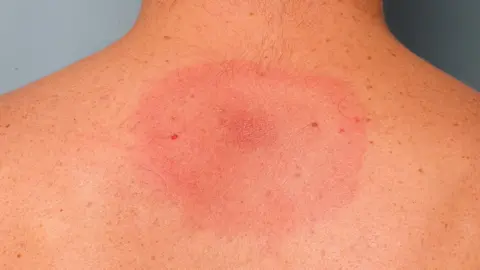Lyme disease: Older white women 'at highest risk'
 Science Photo Library
Science Photo LibraryOlder women are at most risk of contracting Lyme disease, a study suggests - and parts of southern and south-west England are "hotspots".
There are around 3,000 cases of the disease - a bacterial infection carried by ticks - each year in the UK.
But experts say everyone should become aware of the characteristic bulls-eye rash and flu-like symptoms.
More than 2,300 hospital patients with the condition were analysed between 1998 and 2015.
Of all the cases identified in the BMC Public Health study, 60% were women or girls.
On the up
New cases peaked between six and 10 years old and between 61 and 65.
Almost all the 1,877 patients who gave information were white.
Cases overall have gone up - from 0.08 per 100,000 in 1998 to 0.53 per 100,000 in 2015.
The highest incidence of the disease - which is conveyed by ticks, most commonly in grassy and wooded areas - were in south-west England.
Purbeck, in Dorset, topped the list with 3.13 cases per 100,000 annually, followed by the New Forest, and East Dorset.
There are thought to be around 200 cases of the infection each year in Scotland.
Disease 'hotspots'
Dr John Tulloch, from the NIHR Health Protection Research Unit in Emerging and Zoonotic Infections, who led the study, said the rise could reflect greater awareness among both the public and doctors.
And he said the higher numbers of older white women affected could at least partly be down to the fact they were the most likely to seek medical advice.
Dr Tulloch added: "Almost all parts of England and Wales reported Lyme disease cases... with clear hotspots of disease in central southern England.
"This highlights that while Lyme disease poses a risk across both countries, for the majority of people the risk is likely to be very low."

What is Lyme disease?
 Science Photo Library
Science Photo Library- Lyme disease is caused by bacteria carried by some species of ticks - around 13% in the UK are believed to be infected
- It cannot be passed on from person to person
- Symptoms - including the bulls-eye rash, fatigue and fever - usually develop around three weeks after a bite
- The majority of those who take the full three-week course of antibiotics make a full recovery but a few people have symptoms that last for years. It's not clear why this happens, so there is no agreed treatment, but anyone who thinks they have been affected in this way is advised to speak to their doctor
- The New Forest and the Scottish Highlands are known Lyme disease hotspots - but people should take care wherever there is long grass
- The NHS test, which is highly accurate, looks at antibodies the body produces, which can take some weeks to reach detectable levels
Source: Public Health England/NHS

Dr Tim Brooks, clinical services director of the Rare and Imported Pathogens Laboratory at Public Health England, said Lyme disease was still rare.
But he added: "Being aware of the signs and symptoms... is important so you can receive early diagnosis and treatment from your GP.
"When you visit your GP or call NHS 111, remember to tell them where you have been and if you remember being bitten."
